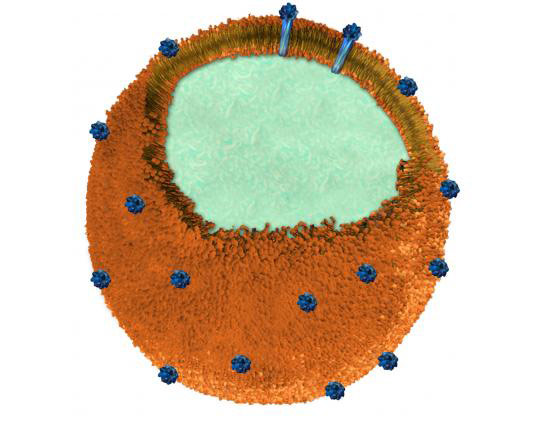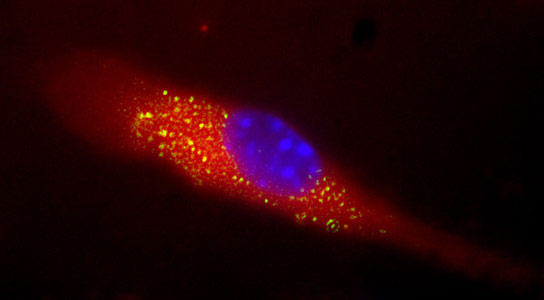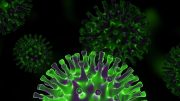
The nanosponges at the foundation of the experimental “toxoid vaccine” platform are bio-compatible particles made of a polymer core (light-blue-green color) wrapped in a red-blood-cell membrane (orange). Each nanosponge’s red-blood-cell membrane seizes and detains the Staphylococcus aureus (staph) toxin alpha-haemolysin (blue) without compromising the toxin’s structural integrity through heating or chemical processing. These toxin-studded nanosponges served as vaccines capable of triggering neutralizing antibodies and fighting off otherwise lethal doses of the toxin in mice. Credit: UC San Diego Department of NanoEngineering
Nanoengineers from UC San Diego have developed nanosponges that soak up a dangerous pore-forming toxin produced by MRSA, and have shown that their nanosponge vaccine was safe and more effective than toxoid vaccines made from heat-treated staph toxin.
Nanosponges that soak up a dangerous pore-forming toxin produced by MRSA (methicillin-resistant Staphylococcus aureus) could serve as a safe and effective vaccine against this toxin. This “nanosponge vaccine” enabled the immune systems of mice to block the adverse effects of the alpha-haemolysin toxin from MRSA—both within the bloodstream and on the skin. Nanoengineers from the University of California, San Diego described the safety and efficacy of this nanosponge vaccine in the December 1 issue of Nature Nanotechnology.
The nanosponges at the foundation of the experimental “toxoid vaccine” platform are bio-compatible particles made of a polymer core wrapped in a red-blood-cell membrane. Each nanosponge’s red-blood-cell membrane seizes and detains the Staphylococcus aureus (staph) toxin alpha-haemolysin without compromising the toxin’s structural integrity through heating or chemical processing. These toxin-studded nanosponges served as vaccines capable of triggering neutralizing antibodies and fighting off otherwise lethal doses of the toxin in mice.
Toxoid vaccines protect against a toxin or set of toxins, rather than the organism that produces the toxin(s). As the problem of antibiotic resistance worsens, toxoid vaccines offer a promising approach to fight infections without reliance on antibiotics.
“With our toxoid vaccine, we don’t have to worry about antibiotic resistance. We directly target the alpha-haemolysin toxin,” said Liangfang Zhang, a nanoengineering professor at UC San Diego Jacobs School of Engineering and the senior author on the paper. Targeting the alpha-haemolysin toxin directly has another perk. “These toxins create a toxic environment that serves as a defense mechanism which makes it harder for the immune system to fight Staph bacteria,” explained Zhang.
Beyond MRSA and other staph infections, the nanosponge vaccine approach could be used to create vaccines that protect against a wide range of toxins, including those produced by E. coli and H. pylori.
This work from Zhang’s Nanomaterials and Nanomedicine Laboratory at UC San Diego included nanoengineering post-doctoral researcher Che-Ming “Jack” Hu, nanoengineering graduate student Ronnie Fang, and bioengineering graduate student Brian Luk.
The researchers found that their nanosponge vaccine was safe and more effective than toxoid vaccines made from heat-treated staph toxin. After one injection, just 10 percent of staph-infected mice treated with the heated version survived, compared to 50 percent for those who received the nanosponge vaccine. With two more booster shots, survival rates with the nanosponge vaccine were up to 100 percent, compared to 90 percent with the heat-treated toxin.
“The nanosponge vaccine was also able to completely prevent the toxin’s damages in the skin, where MRSA infections frequently take place,” said Zhang, who is also affiliated with the Moores Cancer Center at UC San Diego.

The glowing yellow specks in the image show the uptake of the nanosponge vaccine by a mouse dendritic cell — an immune-system cell. The detained alpha-haemolysin toxins were labeled with a fluorescent dye which glows yellow. The nanosponge vaccine with detained toxins can be seen glowing yellow after uptake by the dendritic cell. The cell is membrane stained red and the nuclei stained blue. Credit: UC San Diego Department of NanoEngineering
Fighting Pore-Forming Toxins
This work is a twist on a project the UC San Diego nanoengineers presented earlier this year: a nanosponge that can sop up a variety of pore-forming toxins—from bacterial proteins to snake venom—in the body.
Pore-forming toxins work by punching holes in a cell’s membrane and letting the cell essentially leak to death. But when toxins attack the red blood cell membrane draped over the nanoparticle, “nothing will happen. It just locks the toxin there,” Zhang explained.
The nanoengineers wondered what would happen if they loaded one of their nanosponges with staph toxin in this way, and presented the whole package to an essential part of the immune system called dendritic cells. Could the loaded particles trigger an immune response and work as a toxoid vaccine?
Staph toxin is so powerful that it kills immune cells in its unaltered form. Most vaccine candidates, therefore, use a heat or chemically processed version of the toxin that unravels some of its proteins and makes it a little weaker. But this process also makes the immune response to the toxin a little weaker.
“The more you heat it, the safer the toxin is, but the more you heat it, the more you damage the structure of the protein,” Zhang explained. “And this structure is what the immune cell recognizes, and builds its antibodies against.”
The nanosponge toxoid vaccine gets around this problem by detaining—but not changing—the staph toxin. Like a dangerous but handcuffed prisoner, the staph toxin can be led to the dendritic cells of the immune system without causing any harm.
Before this, “there was no way you could deliver a native toxin to the immune cells without damaging the cells,” Zhang said. “But this technology allows us to do this.”
Each vaccine particle is approximately 85 nanometers in diameter; for comparison, about 1000 of them would fit across the width of a single human hair. They are cleared from the body after injection in about two weeks, the researchers found.
Staphylococcus aureus
Staph bacteria are one of the most common causes of skin infections, and can cause blood poisoning and surgical infections as well as pneumonia. According to the Centers for Disease Control and Prevention, about 80,000 Americans suffer from invasive MRSA infections each year, and over 11,000 of those individuals die. At the moment, there are no vaccines approved to protect humans against the toxins associated with staph infections, including those caused by MRSA strains.
The idea for a staph vaccine came about when the researchers considered the success of their nanosponge. If the particle was so good at collecting toxins, they wondered, what were the potential uses of a particle full of toxin? “To be honest, we never thought about the vaccine use from the beginning,” Zhang noted. “But when we do research, we always want to look at a problem in reverse.”
In a way, the toxoid vaccine hearkens back to their first use for the particles, as a cancer drug delivery device, Zhang noted.
The particles “work so beautifully,” Zhang said, that it might be possible to detain several toxins at once on them, creating “one vaccine against many types of pore-forming toxins,” from staph to snake venom.
The research was funded by the National Institute of Diabetes and Digestive and Kidney Diseases of the National Institutes of Health (award no. R01DK095168) and by the National Science Foundation (grant DMR-1216461).
“Nanoparticle-detained toxins for safe and effective vaccination,” by Che-Ming J. Hu, Ronnie H. Fang, and Liangfang Zhang in the Department of NanoEngineering at the University of California, San Diego; and Brian T. Luk in the Department of Bioengineering at the University of California, San Diego.
Reference: “Nanoparticle-detained toxins for safe and effective vaccination” by Che-Ming J. Hu, Ronnie H. Fang, Brian T. Luk and Liangfang Zhang, 31 November 2013, Nature Nanotechnology.
DOI: 10.1038/nnano.2013.254









Be the first to comment on "Nanoengineers Develop ‘Nanosponge Vaccine’ to Fight MRSA Toxins"